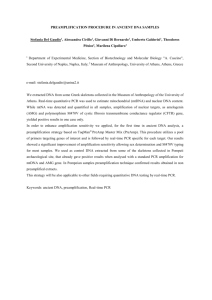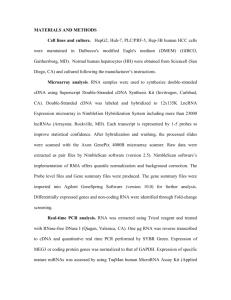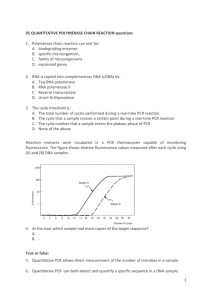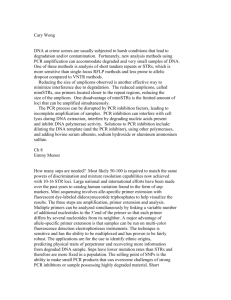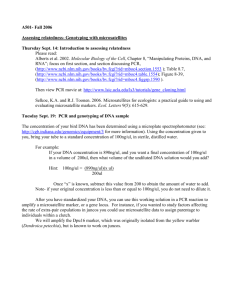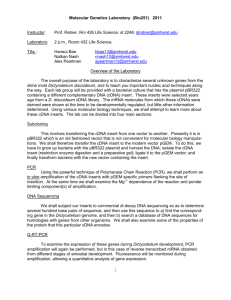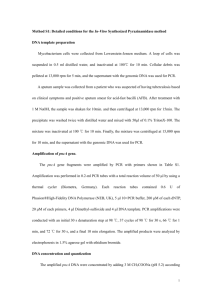52.442 Biochemistry 2
advertisement
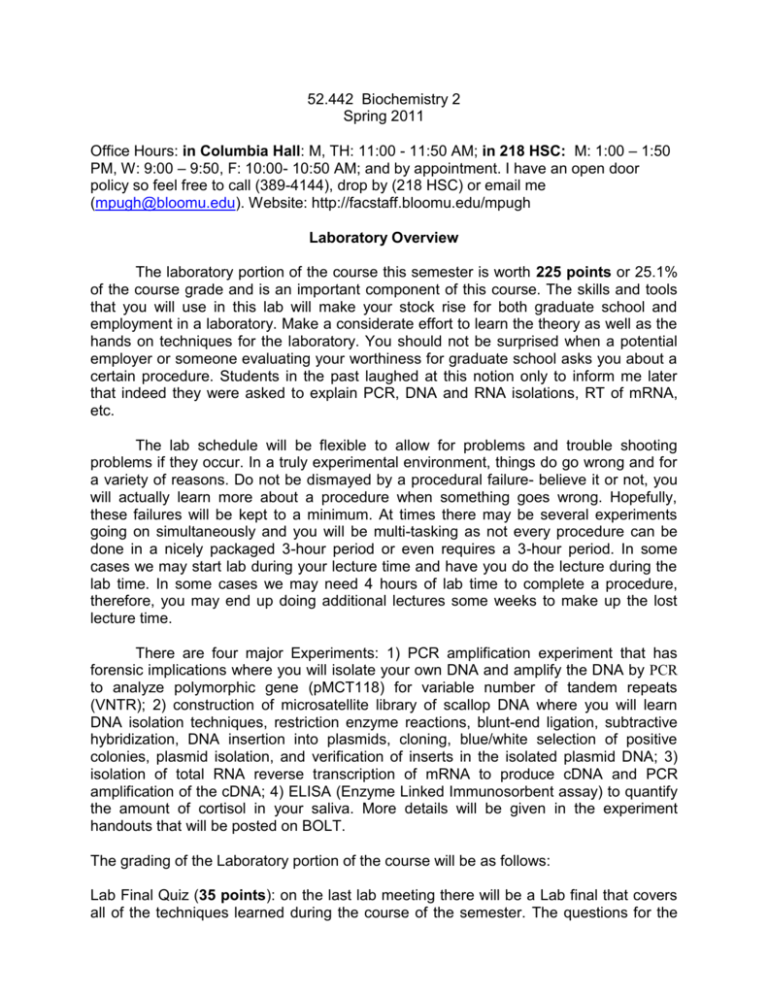
52.442 Biochemistry 2 Spring 2011 Office Hours: in Columbia Hall: M, TH: 11:00 - 11:50 AM; in 218 HSC: M: 1:00 – 1:50 PM, W: 9:00 – 9:50, F: 10:00- 10:50 AM; and by appointment. I have an open door policy so feel free to call (389-4144), drop by (218 HSC) or email me (mpugh@bloomu.edu). Website: http://facstaff.bloomu.edu/mpugh Laboratory Overview The laboratory portion of the course this semester is worth 225 points or 25.1% of the course grade and is an important component of this course. The skills and tools that you will use in this lab will make your stock rise for both graduate school and employment in a laboratory. Make a considerate effort to learn the theory as well as the hands on techniques for the laboratory. You should not be surprised when a potential employer or someone evaluating your worthiness for graduate school asks you about a certain procedure. Students in the past laughed at this notion only to inform me later that indeed they were asked to explain PCR, DNA and RNA isolations, RT of mRNA, etc. The lab schedule will be flexible to allow for problems and trouble shooting problems if they occur. In a truly experimental environment, things do go wrong and for a variety of reasons. Do not be dismayed by a procedural failure- believe it or not, you will actually learn more about a procedure when something goes wrong. Hopefully, these failures will be kept to a minimum. At times there may be several experiments going on simultaneously and you will be multi-tasking as not every procedure can be done in a nicely packaged 3-hour period or even requires a 3-hour period. In some cases we may start lab during your lecture time and have you do the lecture during the lab time. In some cases we may need 4 hours of lab time to complete a procedure, therefore, you may end up doing additional lectures some weeks to make up the lost lecture time. There are four major Experiments: 1) PCR amplification experiment that has forensic implications where you will isolate your own DNA and amplify the DNA by PCR to analyze polymorphic gene (pMCT118) for variable number of tandem repeats (VNTR); 2) construction of microsatellite library of scallop DNA where you will learn DNA isolation techniques, restriction enzyme reactions, blunt-end ligation, subtractive hybridization, DNA insertion into plasmids, cloning, blue/white selection of positive colonies, plasmid isolation, and verification of inserts in the isolated plasmid DNA; 3) isolation of total RNA reverse transcription of mRNA to produce cDNA and PCR amplification of the cDNA; 4) ELISA (Enzyme Linked Immunosorbent assay) to quantify the amount of cortisol in your saliva. More details will be given in the experiment handouts that will be posted on BOLT. The grading of the Laboratory portion of the course will be as follows: Lab Final Quiz (35 points): on the last lab meeting there will be a Lab final that covers all of the techniques learned during the course of the semester. The questions for the quizzes are based on what you did in the laboratory. This will entail explaining a particular procedure, why certain steps are taken, what reagents were used and why they were used, and trouble-shooting (i.e., explain what might have taken place if a certain result is seen). To keep you on your toes lab questions will be given to Dr. Bell to incorporate into her lecture quizzes and her exams. However, the points from these questions will be part of your lecture points. Group Scallop Reports (85 points): there will be two progress reports for the scallop microsatellite experiment, each worth 25 points and a final report worth 35 points. The progress reports will be a summary of what has been accomplished to date for that experiment. These reports will contain results to date that will include appropriate photos of gels, standard curves, any problems to date, and any discussion for improvements. I have done these experiments as an individual and I would like constructive criticism as how you perceive the experiments from the standpoint of a student and as a group exercise. My written comments will also help you write the subsequent reports for this experiment. That is, the second progress report is an extension of the first not a separate report and the final report is a continuation of the previous two progress reports. Therefore you will need to correct the first report errors so I do not have to take off points again for the second, etc. There is a lag time between when the progress report is due and when the lab procedures are completed. You should begin working on your progress report as soon as a procedure is completed so that you can consult with your instructor if need be. Each progress report is worth 15% for a total of 30% of the lab grade. The format for the reports (Report TemplateS11) is in the format of a professional journal and is posted on BOLT in the Course Logistics folder. Also, please see the Laboratory notebook handout for advise on a proper notebook. By following the guidelines for the notebook one should easily convert the recordings into a proper lab report. Other Group reports (105 points): there will be three other reports in the same format as the scallop reports. The pMCT118 PCR amplification report is worth 35 points; the total RNA/reverse transcription/PCR of cDNA report is worth 35 points; and the saliva cortisol ELISA report is worth 35 points. You will be working in groups of two to develop co-operative skills useful for the research team approach to solving problems in both graduate school and industry. Each group member is expected to pull their weight in both the lab, outside of lab and in writing the reports. If there are conflicts with your assigned laboratory partner that need to be straightened out see me as soon as possible. Do not let problems fester to the breaking point. Dr. Bell has her Kentucky whup ass approach, I have my Arizona jumping cholla cactus (Cylindropuntia fulgida) approach. Neither are a pretty sight to behold!


